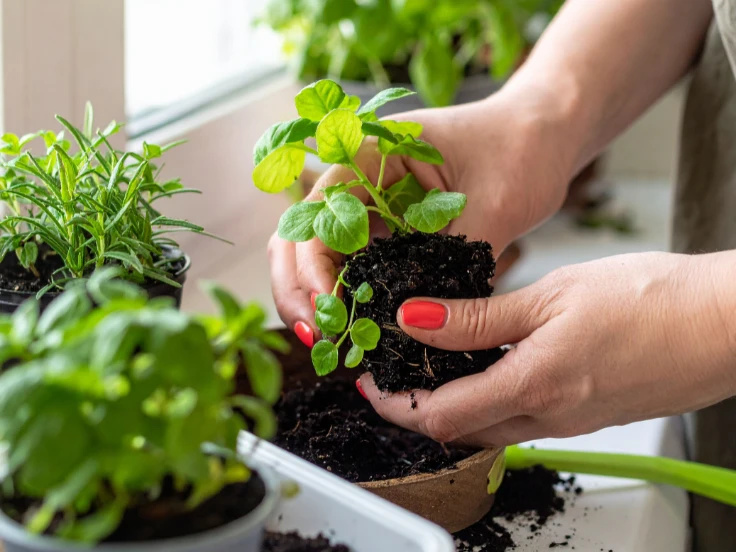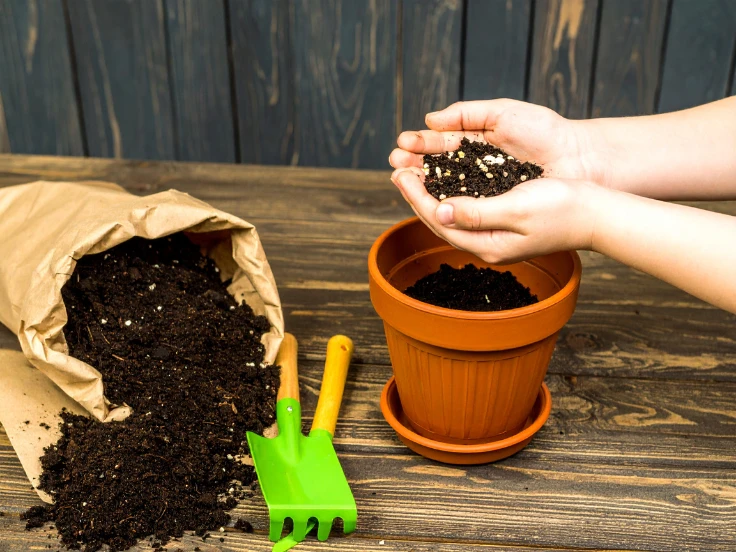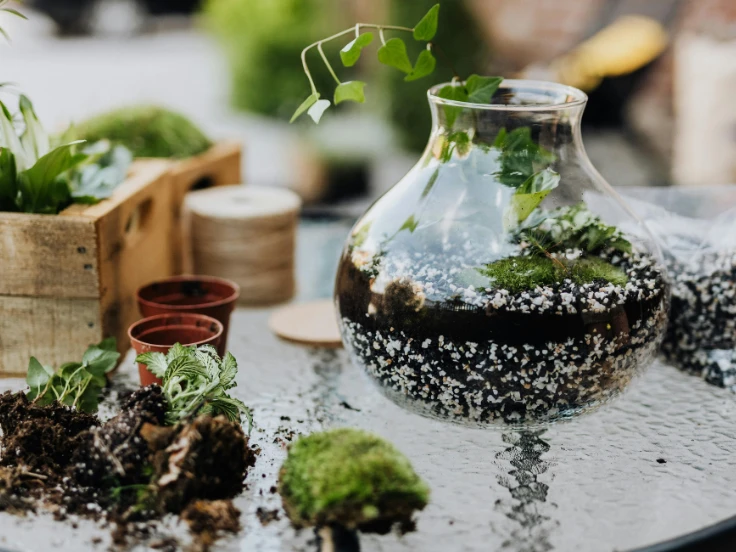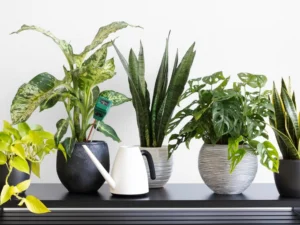Creating the perfect indoor plant soil mixture is both an art and a science. The right blend not only provides essential nutrients but also ensures proper drainage, aeration, and moisture retention, which are crucial for healthy indoor plants. Many indoor gardeners often underestimate the importance of soil composition, leading to stunted growth or unhealthy foliage. A well-balanced soil mixture supports robust root systems and vibrant leaves, making it a key factor in successful indoor gardening.
A well-balanced indoor plant soil mixture is particularly vital for container plants, as they rely entirely on the soil in their pots for sustenance. Understanding the needs of your plants and tailoring the soil mixture accordingly can make all the difference in cultivating a thriving indoor garden.
Indoor plant soil needs vary by species, with succulents requiring fast drainage and ferns favoring moisture-rich mixes. A blend of peat moss, perlite, vermiculite, and compost promotes healthy growth. Adjusting soil pH ensures nutrient availability and prevents issues like yellowing leaves or root rot.
Essential Components of an Indoor Plant Soil Mixture

A thriving indoor plant depends on high-quality soil, with each component supporting growth in a unique way. Peat moss retains water, perlite improves aeration, and compost supplies essential nutrients. Understanding these elements helps gardeners create customized soil mixtures for their plants’ specific needs.
A good indoor plant soil mixture balances moisture retention with proper drainage. This prevents overwatering, root suffocation, and fungal growth. Combining materials with different textures also supports beneficial microbes, enhancing nutrient uptake and overall plant resilience.
How to Choose the Right Soil for Different Indoor Plants
Selecting the appropriate soil mixture for your indoor plants can significantly influence their growth and longevity. Different plant types have distinct requirements, so it is important to tailor the soil accordingly. Choosing the wrong mixture can lead to poor root development, nutrient deficiencies, and even plant death.
-
Succulents and cacti: Require fast-draining, sandy soil with minimal organic matter.
-
Ferns and tropical plants: Thrive in soil rich in organic matter and moisture-retentive components.
-
Orchids: Prefer a chunky, airy mix that allows roots to breathe.
-
Herbs: Need nutrient-rich soil with moderate drainage.
-
Flowering houseplants: Benefit from well-balanced soil that supports both moisture retention and aeration.
Preparing a Custom Indoor Plant Soil Mixture
Creating a personalized soil blend therefore ensures that each plant receives optimal nutrients and water retention. Although commercial potting soils work for many plants, a custom mixture however allows for fine-tuning according to specific plant needs.
-
Step 1: Identify your plant’s water and nutrient requirements.
-
Step 2: Mix peat moss or coco coir for water retention.
-
Step 3: Add perlite or sand for aeration and drainage.
-
Step 4: Incorporate compost or worm castings for nutrients.
-
Step 5: Adjust pH if necessary to match plant preferences.
Benefits of Using a Quality Soil Mixture

Using a high-quality indoor plant soil mixture offers benefits beyond basic plant health. It promotes strong root growth, improving water and nutrient absorption, while reducing risks like overwatering, root rot, and pests. A balanced soil ensures resilience during seasonal changes and inconsistent care.
A well-prepared soil mixture supports beneficial microbial life that aids plant growth. These microorganisms break down organic matter, making nutrients more accessible to roots. This process strengthens plants, reduces the need for chemical fertilizers, and promotes a vibrant, healthy indoor environment.
Soil Amendments That Enhance Indoor Plant Growth

Soil amendments improve the structure and fertility of indoor plant soil mixtures. They provide essential nutrients, better aeration, and prevent waterlogging. Common amendments like compost, perlite, vermiculite, coconut coir, and sand create an optimal medium for healthy plant growth.
Adding perlite or vermiculite improves drainage and prevents root rot in potted plants. Organic compost provides nutrients for lush foliage, while coconut coir offers eco-friendly water retention and aeration. By mixing these amendments thoughtfully, gardeners can create a custom soil mixture that boosts plant health and growth.
Maintaining and Refreshing Indoor Plant Soil
Maintaining your indoor plant soil mixture is crucial for long-term plant health. Over time, soil loses nutrients and may compact, reducing aeration and water retention. Therefore, regular monitoring and refreshing the soil is essential, so your plants continue to thrive, ensuring strong growth and vitality.
-
Top-dressing: Add fresh compost or potting mix to the surface to replenish nutrients.
-
Repotting: Move plants to larger containers with fresh soil every 12–24 months.
-
Aeration: Gently loosen compacted soil to improve root oxygenation.
-
pH check: Monitor soil pH and adjust with lime or sulfur as needed.
-
Organic boosters: Introduce natural fertilizers to maintain nutrient levels.
Common Mistakes When Mixing Indoor Plant Soil
Indoor gardeners often make mistakes that can compromise plant health. Understanding these pitfalls helps prevent common issues such as root rot, stunted growth, or pest infestations. Soil composition, drainage, and nutrient balance are critical factors in maintaining healthy plants.
-
Overcompaction: Using soil that is too dense limits root growth and water flow.
-
Poor drainage: Excessive water retention leads to root rot.
-
Incorrect pH: Nutrient uptake is affected if pH is not suitable for the plant.
-
Ignoring plant needs: One soil mixture does not fit all plant types.
-
Skipping amendments: Lack of organic matter can stunt growth and reduce flowering.
Tips for Eco-Friendly Indoor Soil Mixtures
Eco-friendly indoor soil mixtures focus on sustainability and reducing environmental impact. Using natural and renewable components benefits both plants and the planet. For example, coconut coir, compost, and organic fertilizers provide nutrients without depleting non-renewable resources. Additionally, avoiding chemical fertilizers helps prevent indoor pollution and maintains a healthier living environment.
-
Use coconut coir instead of peat moss.
-
Incorporate homemade compost from kitchen scraps.
-
Choose natural fertilizers over synthetic options.
-
Reuse and sterilize pots to reduce waste.
-
Rotate soil amendments seasonally to maintain soil vitality.
Frequently Asked Questions (FAQs)
Q1: Can I use garden soil for indoor plants?
Garden soil is not recommended because it can contain pests and compact easily, preventing proper drainage and root growth.
Q2: How often should I refresh my indoor plant soil?
Typically every 12–24 months, or when you notice nutrient depletion, compaction, or poor plant growth.
Q3: Can I mix different soil types for my indoor plants?
Yes, blending soils like peat moss, compost, and sand allows for a customized mixture suitable for various plant needs.
Conclusion
Mastering indoor plant soil mixtures is essential for healthy houseplants. Understanding plant requirements and selecting the right soil components ensures vibrant growth. For example, indoor citrus plants like lemons need well-draining soil and proper nutrients, which you can explore in our indoor lemon plant care guide.
Whether growing succulents, ferns, orchids, or herbs, a well-balanced soil mixture supports root development, nutrient absorption, and overall plant vitality. Additionally, using eco-friendly treatments, such as neem oil for indoor plants, can help protect your greenery from pests while promoting a healthier, greener home environment.
Interestingly, just as exploring Hamburg places to visit requires careful planning and knowledge, creating the perfect indoor soil mixture demands thoughtful consideration and customization. Both endeavors reward those who approach them with attention to detail and a love for growth whether of plants or experiences.


















